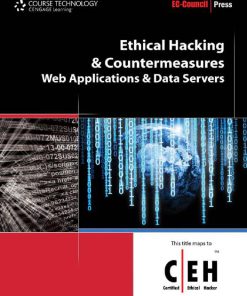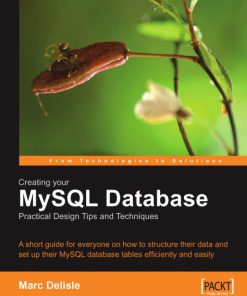Practical Hacking Techniques and Countermeasures 1st edition by Mark Spivey ISBN 0849370574 9780849370571
$50.00 Original price was: $50.00.$25.00Current price is: $25.00.
Authors:Mark D. Spivey , Series:Cyber Security [217] , Tags:Business & Economics; Commerce; Computers; Information Technology; Security; General , Author sort:Spivey, Mark D. , Ids:Google; 9781420013382 , Languages:Languages:eng , Published:Published:Nov 2006 , Publisher:CRC Press , Comments:Comments:Practical Hacking Techniques and Countermeasures examines computer security from the hacker’s perspective, demonstrating how a security system can be designed and structured to repel an attack. This book shows how an attack is conceptualized, formulated and performed. With the VMware Workstation software package available on the accompanying CD, it uses virtual computers to illustrate how an attack is executed, including the script, compilation, and results. It offers examples of attacks on Windows and Linux. It also covers such topics as footprinting, scanning, sniffing, passwords, and other attack tools. This text provides valuable information for constructing a system to defend against attacks.
Practical Hacking Techniques and Countermeasures 1st edition by Mark D. Spivey – Ebook PDF Instant Download/Delivery. 0849370574, 978-0849370571
Full download Practical Hacking Techniques and Countermeasures 1st Edition after payment

Product details:
ISBN 10: 0849370574
ISBN 13: 978-0849370571
Author: Mark D. Spivey
Examining computer security from the hacker’s perspective, Practical Hacking Techniques and Countermeasures employs virtual computers to illustrate how an attack is executed, including the script, compilation, and results. It provides detailed screen shots in each lab for the reader to follow along in a step-by-step process in order to duplicate and understand how the attack works. It enables experimenting with hacking techniques without fear of corrupting computers or violating any laws.
Written in a lab manual style, the book begins with the installation of the VMware® Workstation product and guides the users through detailed hacking labs enabling them to experience what a hacker actually does during an attack. It covers social engineering techniques, footprinting techniques, and scanning tools. Later chapters examine spoofing techniques, sniffing techniques, password cracking, and attack tools. Identifying wireless attacks, the book also explores Trojans, Man-in-the-Middle (MTM) attacks, and Denial of Service (DoS) attacks.
Learn how to secure your computers with this comprehensive guide on hacking techniques and countermeasures
By understanding how an attack occurs the reader can better understand how to defend against it. This book shows how an attack is conceptualized, formulated, and performed. It offers valuable information for constructing a system to defend against attacks and provides a better understanding of securing your own computer or corporate network.
Practical Hacking Techniques and Countermeasures 1st Table of contents:
-
Preparation
- The first step in any cybersecurity operation is preparation. This includes understanding the environment, the potential attack vectors, and the security measures in place. Preparation involves gathering tools, setting up environments for testing, and developing strategies for engagement.
-
Social Engineering
- Social engineering is a manipulation technique where attackers deceive individuals into divulging confidential information. This often involves exploiting human trust and behaviors rather than technical vulnerabilities. Common methods include phishing, pretexting, baiting, and tailgating.
-
Footprinting
- Footprinting refers to the process of gathering information about a target system or organization to find potential vulnerabilities. This can involve passive or active techniques, such as researching domain names, IP addresses, DNS records, and even public records, to build a profile of the target.
-
Scanning
- Scanning is a method of identifying open ports, services, and vulnerabilities in a network or system. It is often used in penetration testing and ethical hacking to map out potential attack surfaces. Tools like Nmap are commonly used to perform network scans.
-
Sniffing
- Sniffing refers to the practice of intercepting and monitoring data traveling through a network. Attackers use sniffers to capture packets of information such as login credentials or other sensitive data. This can be done in unencrypted communication channels or with the use of malicious tools.
-
Spoofing
- Spoofing occurs when an attacker impersonates a legitimate entity to gain unauthorized access or deceive users. Types of spoofing include IP spoofing (faking an IP address), email spoofing (disguising the sender’s email address), and DNS spoofing (redirecting users to fake websites).
-
Passwords
- Passwords are one of the most common methods of authentication but are often weak and vulnerable. Strong password practices, such as using long, complex passwords and multi-factor authentication (MFA), are essential in preventing unauthorized access. Password cracking tools can be used by attackers to guess or brute-force passwords.
-
Exploits and Attacks
- Exploits are methods by which an attacker takes advantage of a vulnerability in software or hardware to gain unauthorized access or control. Types of attacks include SQL injection, cross-site scripting (XSS), buffer overflows, and others that target weaknesses in systems.
-
Wireless Security
- Wireless networks are susceptible to attacks such as eavesdropping, man-in-the-middle attacks, and unauthorized access. Securing wireless networks involves encryption protocols like WPA3, strong password policies, and limiting network access using MAC address filtering.
-
Trojans
- A Trojan is a type of malware that masquerades as a legitimate program but contains harmful code. Once installed, Trojans can allow attackers to gain control over the victim’s system, steal data, or perform other malicious actions without detection.
-
Man-in-the-Middle (MITM) Attacks
- In a man-in-the-middle attack, the attacker secretly intercepts and possibly alters the communication between two parties. MITM attacks can happen over unencrypted communication channels, allowing attackers to capture sensitive data or inject malicious content.
-
Hiding Data
- Data hiding refers to techniques used by attackers or security professionals to conceal information, often to evade detection. This could involve steganography, where data is embedded within other files or images, or using encrypted containers to hide files.
-
Port Redirection
- Port redirection is the process of forwarding network traffic from one port to another. This technique can be used by attackers to bypass firewalls, exploit services running on non-standard ports, or redirect traffic to a compromised server.
-
Denial of Service (DoS)
- A Denial of Service attack aims to disrupt the normal functionality of a service, network, or server by overwhelming it with a flood of traffic or requests. A Distributed Denial of Service (DDoS) attack involves multiple systems generating high traffic, making the attack harder to mitigate.
People also search for Practical Hacking Techniques and Countermeasures 1st :
counter hacking techniques
types of hacking techniques
a practical model for conducting cyber threat hunting
hacking hacking practical guide for beginners
a practical guide to digital forensics investigations
You may also like…
eBook PDF
Practical Plastic Surgery 1st Edition by Zol Kryger, Mark Sisco ISBN 9781498713283 1498713289












